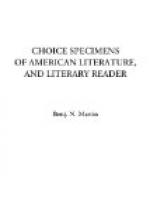* * * * *
=_Ephraim C. Squier, 1821-._= (Manual, p. 504.)
From “Aboriginal Monuments of the West.”
=_267._= INDIAN POTTERY.
The site of every Indian town throughout the west is marked by the fragments of pottery scattered around it; and the cemeteries of the various tribes abound with rude vessels of clay, piously deposited with the dead. Previous to the discovery, the art of the potter was much more important, and its practice more general than it afterwards became, upon the introduction of metallic vessels. The mode of preparing and moulding the materials is minutely described by the early observers, and seems to have been common to all the tribes, and not to have varied materially from that day to this. The work devolved almost exclusively upon the women, who kneaded the clay and formed the vessels. Experience seems to have suggested the means of so tempering the material as to resist the action of fire; accordingly we find pounded shells, quartz, and sometimes simple coarse sand from the streams mixed with the clay. None of the pottery of the present races, found in the Ohio valley, is destitute of this feature; and it is not uncommon, in certain localities, where from the abundance of fragments, and from other circumstances, it is supposed the manufacture was specially carried on, to find quantities of the decayed shells of the fresh water molluscs, intermixed with the earth, probably brought to the spot to be used in the process. Amongst the Indians along the Gulf, a greater degree of skill was displayed than with those on the upper waters of the Mississippi, and on the lakes. Their vessels were generally larger and more symmetrical, and of a superior finish. They moulded them over gourds and models, and baked them in ovens. In the construction of those of large size, it was customary to model them in baskets of willow or splints, which, at the proper period, were burned off, leaving the vessel perfect in form, and retaining the somewhat ornamental markings of their moulds. Some of those found on the Ohio seem to have been modelled in bags or nettings of coarse thread or twisted bark. These practices are still retained by some of the remote western tribes.




